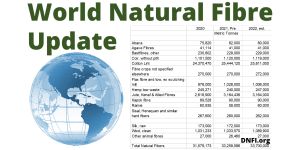 Depending on the continent and climate zone, natural fibers grow all year round. The dependence on local and global weather influences changes the quality and quantity of the fibers at the time of harvest or during and after cleaning and processing.
Depending on the continent and climate zone, natural fibers grow all year round. The dependence on local and global weather influences changes the quality and quantity of the fibers at the time of harvest or during and after cleaning and processing.
Geopolitical or regional events are other factors affecting the availability of natural fibers. In the case of statistical evaluations, it must be taken into account that some regional harvest periods also take place at the turn of the year.
World natural fibre production in 2024 is estimated at 31.8 million metric tonnes. Prospects for 2024 world natural fibre production deteriorated for the third consecutive month in September, falling 300,000 tonnes to 31.8 million. The decline in September was in addition to reductions totalling 800,000 tonnes in July and August, and a year that started optimistically, forecast to see the highest level of production since 2017, is now forecast to be just average.
Production in 2024 is expected to include 25.3 million tonnes of cotton, 2.6 million tonnes of jute, 1.2 million tonnes of coir, 1 million tonnes of clean wool and 1.6 million tonnes of all other fibres combined. If realized, production in 2024 will be just 200,000 tonnes higher than in 2023. The record for world natural fibre production is 35 million tonnes in 2011.
Excerpt from the 7 page report October 2024 (+ 6 graphs and 1 table):
…. Prices of most natural fibres increased during September, indicating a …. The nearby cotton futures contract (December 2024) on the Intercontinental Exchange (ICE) finished September at $1.xx …. The Eastern Market Indicator for merino wool in Australia was up 1% to US$7.xx …. Prices of Western European flax long fibre, ex scutching mill, averaged over all qualities, converted to US$, seem finally to be moderating. Prices fell to US$9.xx …. Prices of Brazilian sisal, Bahia, Type 3 DB, FOB Salvador were quoted at US$1.xx …. The Indian Jute Balers Association (JBA) market quotes converted to USD rose to $ …. Prices of abaca, S2, FOB Manila, were steady at $ …. Production of Wool in Australia in 2024 (the 2023/24 season) is estimated down to ….
Free Download of the 7 page report: “DNFI World Natural Fibre Update October 2024”
Please note the download link send to you will automatically expire after 7 days.
DNFI members can access previous reports here: https://dnfi.org/dnfi-world-natural-fibre-updates/
The DNFI World Natural Fibre Update is provided by: Dr. Terry Townsend, DNFI Statistics and Data Analysis Expert.
Related Posts

